When it comes to Visita Iglesia tours in Metro Manila during Holy Week, certain churches always come to mind. I always think of visiting the oldest and most historic Baroque churches that date back to the Spanish colonial era. There’s San Agustin Church, the oldest stone church; San Sebastian Church, the only steel church; and Quiapo Church, which enshrines the Black Nazarene icon, to name a few.
While older churches may have more historical value, visiting modern churches and chapels has its appeal. Newer churches often provide better amenities, including easier access by public transportation, or better parking areas (a valid concern for many urban dwellers). They also tend to have a more welcoming and inclusive atmosphere or are located in areas that are peaceful and conducive to prayer and reflection.
Contemporary churches can also show a different side of the country’s rich architectural diversity and design philosophies.
If you’re looking for less crowded and beautifully designed churches to visit this Holy Week, here are just a few around Metro Manila you might want to consider.
Church of the Holy Sacrifice
The Church of the Holy Sacrifice, completed in 1955, is notable for being the first circular chapel in the country. Serenely located within the UP Diliman Campus in Quezon City, this landmark church was designed by National Artist for architecture Leandro V. Locsin. Often likened to a flying saucer, due to its thin-shell concrete dome and ring beam, the church is considered an outstanding example of contemporary architecture of the 1950s.
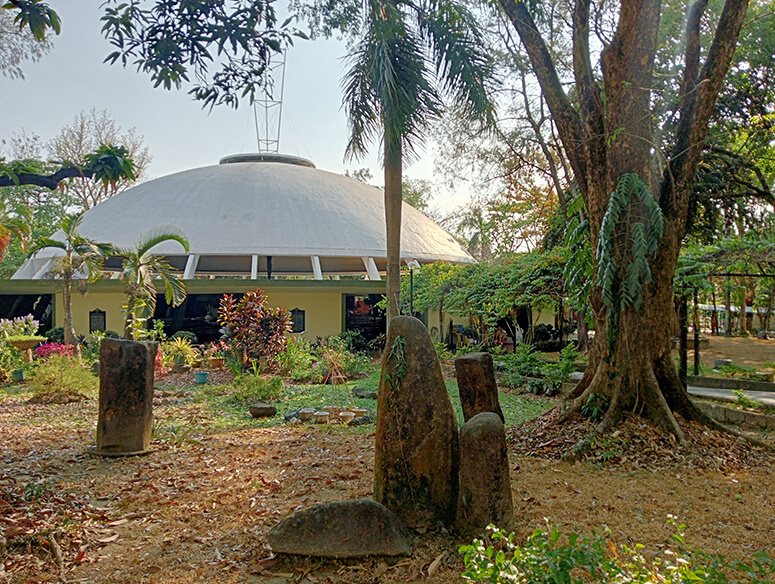
According to the architectural website ArchDaily, Locsin’s design combines “elements of traditional Filipino architecture with postwar International aesthetics” making it a Modernist icon and symbol of a newly independent nation.
This church is also the only structure in the country to feature the works of not just one, but five national artists. Aside from Locsin, other national artists who contributed to the building’s interior include Vicente Manansala and Ang Kiukok (Stations of the Cross), Arturo Luz (the River of Life floor mosaic), and Napoleon Abueva (Crucifix and marble altar).
No wonder it’s been recognized as a National Historical Landmark by the National Historical Commission of the Philippines (NHCP) and a Cultural Treasure by the National Museum of the Philippines.
St. Andrew the Apostle Parish
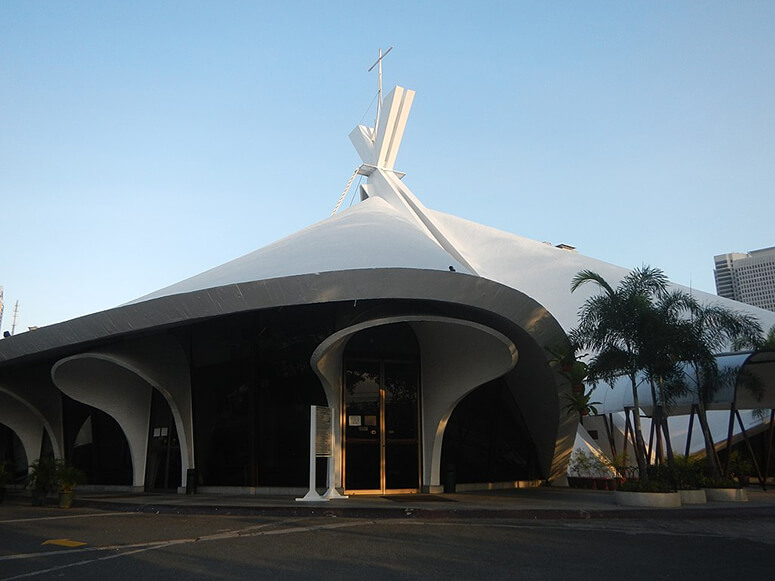
Another modern cultural landmark designed by National Artist Leandro V. Locsin is St. Andrew the Apostle Parish in Bel-Air II, Makati City, completed in 1968. This church is known for its distinctive X-shaped cross, butterfly-like roof and tent-like structure, symbolizing the martyrdom of St. Andrew who was crucified on an X-shaped cross. The tent-like structure contains a giant chandelier over the altar, which serves as a halo over the copper cross designed by National Artist for Visual Art Vicente Manansala.
The Church of the Gesu
The Church of the Gesu, completed in 2003, has been recognized as a “shining embodiment of Philippine culture and heritage.”
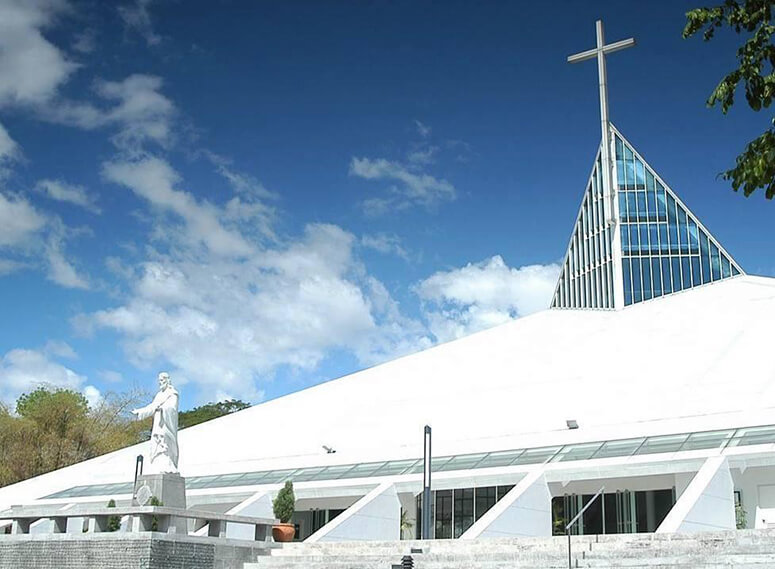
Nestled in between the various buildings and the sprawling greens of the Ateneo de Manila University campus in Quezon City, this church with its distinctive triangular form is tall and wide, with slanted roofs, white walls, and wide windows.
Designed by Jose Pedro Recio and Carmelo Casas, this church is utilitarian, yet representative of contemporary Filipino architecture. The church’s triangular structure is said to symbolize the Holy Trinity. The skylights above, large windows and doors for cross ventilation create a modern minimalist space for churchgoers to focus on the sanctity of the space. In front of the church is a Sacred Heart statue depicting Jesus with welcoming, outstretched arms.
In a feature on the Ateneo de Manila University’s website describing the church’s vision: they say: “The Gesu’s design also evokes the qualities of the traditional Bahay Kubo and values of openness, transparency, multifunctionality, and harmony with the environment.”
In 2017, the church was selected by the National Commission for Culture and the Arts (NCCA) as a Filipino symbol, and honored for its expression of Filipino identity and the Atenean mission.
Our Lady of Lourdes Chapel
For those based in the south of the metro, Our Lady of Lourdes Chapel in Filinvest City, Muntinlupa is another stunning chapel that stands out in terms of design. The chapel opened to the public in October 2022.
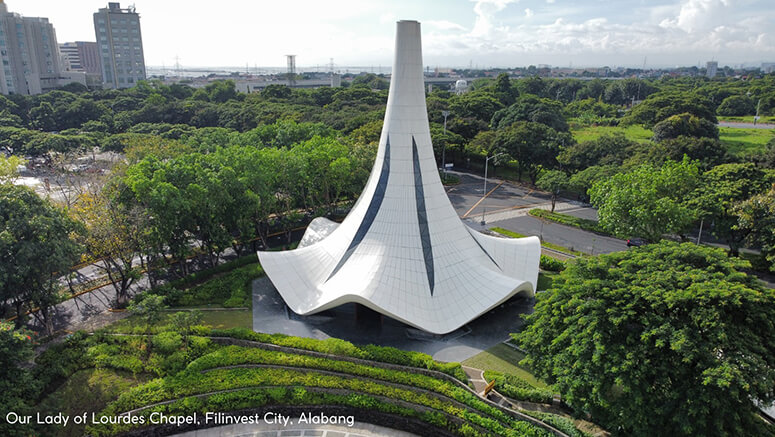
With its striking white facade and curved roof topped with a 98-foot-high spire, this chapel surrounded by greenery offers an elegant place of worship. Our Lady of Lourdes Chapel was designed by Tokyo-based architect Hiroshi Nakamura & NAP Architects, taking a white lily as its main design inspiration, symbolizing purity and the Virgin Mary.
As per Architectural Record, the church was the result of an invited competition hosted by the client, Filinvest Alabang. While Nakamura is behind other places of worship in Japan, including the Sayama Forest Chapel and the Ueno Toshogu Shrine Meditation Pavilion, this is his first completed work in the country.
Our Lady of Lourdes Chapel received a 5-star rating in the Public Service Architecture category at the 2024 Asia Pacific Property Awards and won at the London Design Awards.
Sagrada Familia Church
For those based in Quezon City, the Sagrada Familia Church is another inspiring – and easily accessible spot where you can combine mall visits and mass. This striking chapel on the 5th level of the new Gateway 2 Mall in Araneta City, Cubao, opened just last September 2023.
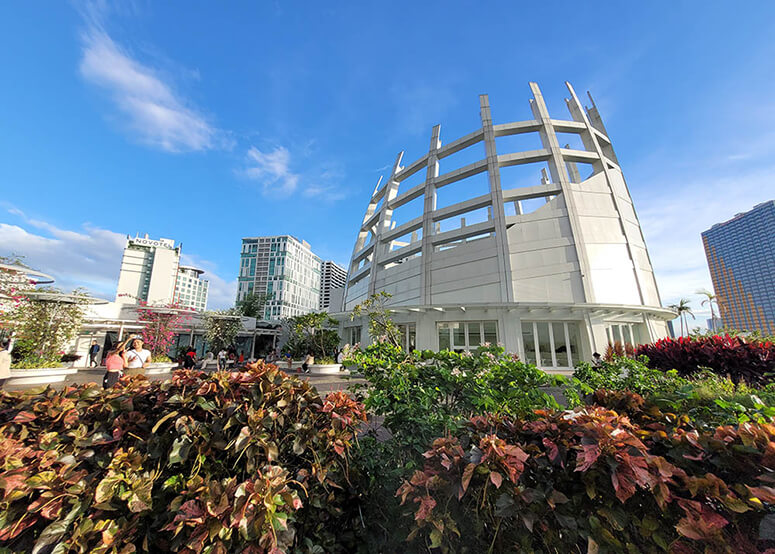
The unique shaped curved facade with beams sticking out actually takes inspiration from the mitre, a traditional headwear worn by senior officials of the Catholic Church like bishops, archbishops, cardinals, and the Pope.
According to Araneta City, the chapel highlights an all-white interior, inspired by The Oculus (an aesthetically stunning transit hub) in New York City, with high ceilings that feature a hanging cross created by sculptor Wilfredo Layug.
The church, which is fully airconditioned and can fit up to 1,000 worshippers at a time, has modern glass walls to invite natural light adding to the serene ambiance. The church is also surrounded by landscaped gardens, with water elements and blooming flowers, offering a quiet spot in the middle of the busy city.
Whether you’re seeking spiritual reflection or architectural inspiration this Holy Week (and beyond), these sacred spaces will leave you with a sense of renewal.
For more travel stories, visit the author’s blog at www.traveling-up.com.
